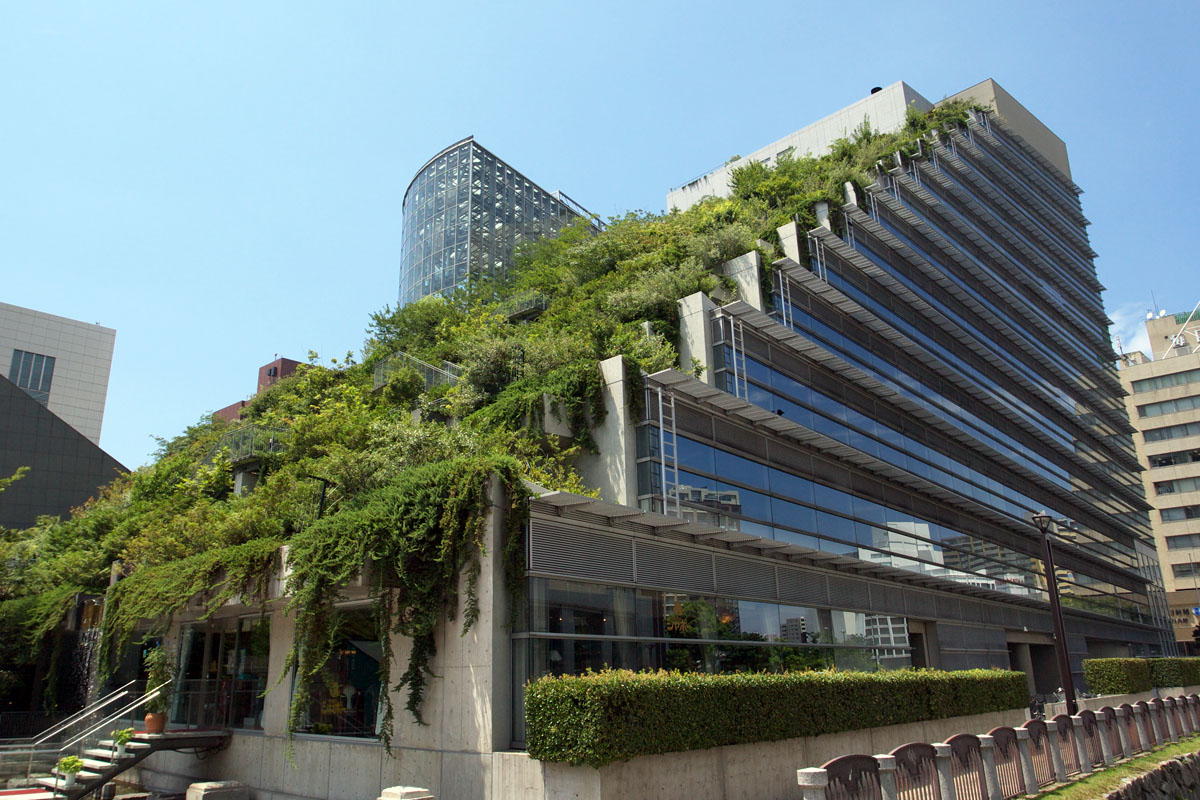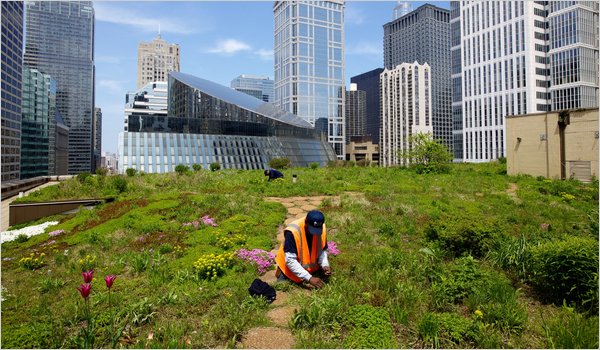By Austa Somvichian-Clausen, Communications Intern
A green roof — or living roof — can be defined as the roof of a building that is partially or completely covered with vegetation and a growing medium, planted over a waterproofing membrane.
Green roofs have a number of benefits such as providing habitat for birds, absorbing airborne pollutants, drastically reducing sewer overflow by retaining rainwater and reducing the urban heat island effect whereby high concentrations of concrete buildings and asphalt increase air temperature.
In the United States, cities like Washington, D.C., Chicago, Philadelphia and New York City now offer financial incentives for installing green roofs. Installations have almost doubled since 2008, and now more than 17.5 million square feet of roofs across the country are considered “green.”
Besides the benefits that green roofs provide for the environment, they also offer aesthetic benefits. Adding a green roof to any building can significantly add to its aesthetic appeal. Take a look at this short list of a few of the more notable and beautiful green roofs around the world.
Museé du Quai Branlys Vertical Garden – Paris, France
Designed and planted by French botanist Dr. Patrick Blanc, the 650-foot-long and 40-foot high Musée du quai Branly greenwall is one of Blanc’s most famous vertical gardens, and one of the most highly photographed in the world. Facing the River Seine with a park and small streets in between, the micro-climate creates a good environment for a large variety of plants.
A reason to celebrate:
Thanks to a French law that passed last March, rooftops on new buildings in commercial zones across France must either be partially covered in plants or solar panels. The law was approved by French Parliament and was actually scaled back from initial proposals by environmental groups asking for green roofs to cover the entire rooftop surface of all new buildings. Similar green roof bylaws exist in various cities around the world, including Tokyo, Toronto, Copenhagen and Zurich.
The California Academy of Sciences Living Roof – San Francisco, Calif., United States
One of the most well-known green roofs we have today is located at the Academy of Sciences (CAS) in San Francisco, Calif. Weather stations on the green roof monitor wind, rain and changes in temperature to help inform the building’s automated systems and skylights, which helps keep the interior piazza cool and comfortable, and natural light streaming to the exhibits below.
According to the CAS website: “Edged by solar panels, the roof’s seven hills are lined with 50,000 porous, biodegradable vegetation trays made from tree sap and coconut husks. An estimated 1.7 million plants fill the trays, their roots interlocking to create an extraordinary oasis for birds, insects, people, and other creatures.” The Academy is also the world’s first Double Platinum LEED-certified museum, and the largest Double Platinum building on the planet.
The Vancouver Convention Centre – Vancouver, BC, Canada
The Vancouver Convention Centre’s West building is home to a six-acre living roof — the largest in Canada and the largest non-industrial living roof in North America. The sprawling green roof features more than 400,000 indigenous plant and grasses and is designed to act as an insulator, reducing heat gains in the summer and heat losses in the winter. The underside of the roof is lined with beautiful Douglas fir slats, a locally harvested material.
A unique feature of the roof is the four beehives where they keep European honey bees. The bees help pollinate the plants on the living roof while supplying honey for the kitchen.
The Nanyang Technological University – Singapore
The key feature of the university’s School of Art Design and Media is its picturesque green roof that slopes almost at a 45-degree angle. The sunken, almond shaped courtyard is formed by the space in between the building’s two main arms and is beautifully reflected from the interior high performance, double-glazed glass curtain wall facades. The green roof doubles as a scenic outdoor communal space and a way to keep ambient temperature low and reduce heat in the daytime. In addition, the reflective pond in the central courtyard provides a cool visual respite and helps to cool the center space.
The roof turf consists of a combination of two grasses, Zoysia matrella and Ophiopogon. Under the grass roof are four layers of interrelated matter, which include crushed volcanic rocks, pumice and washed sand (for the grass to root), as well as a moisture retention mat. The turfgrass remains green and healthy year round via an automatic sprinkler system using harvested rainwater.
The Global Change Institute at the University of Queensland – Brisbane, Australia
Located in the sub-tropical climate of Brisbane, the University of Queensland (UQ)is committed to incorporating sustainability into every aspect of its campus. The 5-story Global Change Institute is the first educational Living Building Challenge-registered project in Queensland, and the UQ’s landmark zero-carbon, 6-star Green Star rated collaborative hub generates more energy than it consumes.
The building features a sun-shading system that tracks the sun and protects the glass louvers, which create natural ventilation. The air flows across occupied office spaces to the central atrium, which acts as the building’s lungs, discharging warm air through its thermal chimney. An onsite greywater system, bush tucker garden, bio-retention basin and greenwalls enhance the building’s green features.
Check out the Global Change Institute’s site to check out more of the building’s cool features.
ACROS Fukuoka Prefectural International Hall – Fukuoka City, Japan
Pioneering green architect Emilio Ambasz transposed a nearly 100,000-square-meter park in the city center onto 15 stepped terraces of the ACROS Fukuoka Prefectural International Hall. The design for ACROS Fukuoka proposes a powerful new solution for a common urban problem: reconciling a developer’s desire for profitable use of a site with the public’s need for open green space. The plan for Fukuoka fulfills both needs in one structure by creating an innovative agro-urban model.
Chicago City Hall Green Roof – Chicago, Ill., United States
Chicago’s most famous rooftop garden sits atop City Hall. First planted in 2000, the City Hall rooftop garden was conceived as a demonstration project to test the benefits of green roofs and how they affect temperature and air quality. The garden consists of 20,000 plants of more than 150 species, including shrubs, vines and two trees. The plants were selected for their ability to thrive in the conditions on the roof, which is exposed to the sun and can be windy and arid. Most are prairie plants native to the Chicago region.
The City Hall rooftop garden improves air quality, conserves energy, reduces stormwater runoff and helps lessen the urban heat island effect. The garden’s plants reflect heat, provide shade and help cool the surrounding air through evapotranspiration.






